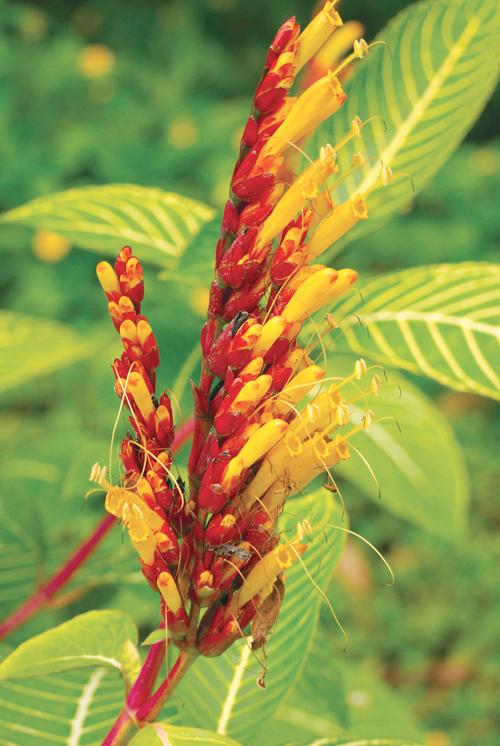Phuket Gardening: Doctor’s delight – more cover-ups

PHUKET: This week opens the ‘last chance saloon’ door to a few more multicolored foliage shrubs. And in fact, two or three are consistent performers and might rightly feel miffed if not given a mention.
Indeed one, sanchezia nobile, prompted an enthusiastic Floridian to write on the web as follows: “Does anybody know about this plant? I saw it here in town and I just had to get a cutting.” I don’t know if he found what he wanted, but the good news for Phuketians is that not only will it grow readily from cuttings, but that it is readily available in plant nurseries here.
Sometimes confused with the codiaeum (croton), its leaves are quite similar, since sanchezia has similarly deep green, oval foliage with deep yellow or white veining.
Glossy and leathery, the spectacular leaves, produced in opposite pairs, are comparable in size to those of the croton – up to a foot long in the right conditions.
And the right conditions mean good soil, a consistent supply of water and full or filtered sun. Potted specimens, for example, will wilt rapidly if the soil is allowed to dry out.
While it does not have the spectrum of colors possessed by the croton, this tropical American native named after a certain Dr Sanchez, has other compensations. It is a fast grower, makes a sizable bush (up to five feet) and has quite showy yellow flowers with bright tubular red bracts. Right now, it is blooming away in my patch.
Our Floridian friend said these blooms looked like hibiscus flowers, but I put that observation down to an aberrant memory – or an excess of enthusiasm. But the shrub is well worth a try and makes an unusual addition to your flower bed. If you want a bushier plant, remember to pinch out the growing tips.
The next plant comes with a health warning. Its common name, “the blindness tree”, affords a clue – the sap is toxic and may be injurious to the eyes, though it does also have medicinal uses.
The shrub that’s in question, excoecaria cochinchinensis (the latter epithet is simply an old word for Vietnam), is a bushy, woody shrub, with masses of shiny, papery leaves.
What make it distinctive is that the upsides of the leaves are dark green (sometimes with white or pinkish variegations), but are deep maroon underneath. It is becoming increasingly popular here: one cultivar, “firestone”, has strongly contrasting leaf coloration. Its dense habit means it can be used as a hedge or border plant and will tolerate clipping. Distinctly useful.
Last through the swinging doors is polyscias, sometimes referred to as panax. This is another shrub that can be brought into service as a hedging plant and is often employed in this fashion by Thai gardeners. Strictly speaking it is more a two-tone variegated plant than a multi-colored one, rarely deviating from green and white patterned foliage.
Quercifolia (oak-leaved), the commonest variety here, has smallish, wavy-edged foliage and a vertical habit. If you intend to use it for a barrier or border you will need to put the young plants close together. Trim the top growth if you want a bushier specimen.
Polyscias is hardy, and will tolerate low levels of moisture. Moreover, it is evergreen and there are increasingly attractive varieties available. Marginata, for example, has dramatic blotches of bright yellow on the leaf edges. The shrub has achieved a new lease of life as a house plant, especially in America, where there are many cultivars with varied leaf shapes. “Ruffles”, “parsley” and “spinach” should give you a clue.
Enough to be going on with? I think so.
Tip of the week: Controlling pests
Employ chemical controls, including pesticides, only as a last resort. If you maintain good cultural practices and if your plants are consequently robust and healthy, they are less likely to be attacked, or to succumb to disease.
Choose plants that are right for a tropical climate, select plants for specific conditions in your garden such as shade or sun, prepare planting beds well with plenty of organic matter, and water, fertilize and prune as required. Check your plants regularly to ensure they are healthy and vigorous.
You can limit pest problems by the simple expedient of handpicking. In this way, you can remove caterpillars, snails and insect egg masses. Look for telltale damage to leaves caused by caterpillars or grasshoppers, and inspect for droppings under your plants. Always inspect beneath the leaves.
If you have a question or a garden that you would like featured, you can email the author here.
Keep checking our online Phuket Lifestyle pages or join our Facebook fan page for regular gardening features and tips.
— Patrick Campbell
Join the conversation and have your say on Thailand news published on The Thaiger.
Thaiger Talk is our new Thaiger Community where you can join the discussion on everything happening in Thailand right now.
Please note that articles are not posted to the forum instantly and can take up to 20 min before being visible. Click for more information and the Thaiger Talk Guidelines.
Leave a Reply
You must be logged in to post a comment.









